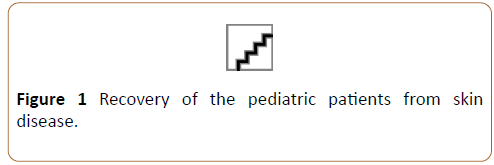Vihar R Bidwai1*, Sanjay P Gumble2, Shailesh Pawade3, Arun Rangrao Deshmukh4 and Mrunali Morey1
1Deptarment of Shalya Tantra, Ayurved College Pusad, Maharashtra, India
2Department of Sanskrit Samhita Siddhant, Ayurved College Pusad, Maharashtra, India
3Department of Rasashashtra, Ayurved College Pusad, Maharashtra, India
4Department of Dravyagunavigyan, MUP's Ayurved College, Hospital and Research center, Degaon, Risod, India
*Corresponding Author:
Vihar R. Bidwai
Department of Shalya Tantra
Ayurvedic Mahavidyalaya, Pusad, India
Tel: 91-9822299174
E-mail: vihar4u@gmail.com
Received Date: December 14, 2017 Accepted Date: January 22, 2018 Published Date: January 29, 2018
Citation: Bidwai VR, Gumble SP, Pawade S, Deshmukh AR, Morey M (2018) Shatdhauta Ghrita - A Evaluation Study in Pediatrics. Ped Health Res. Vol. 3 No.1:2. doi: 10.21767/2574-2817.100027
Keywords
Ghrita; Samskara; Dhauta; Skin disease
Introduction
Shatdhauta Ghrita is the medicinal preparation in ayurveda by giving different types of sanskara [1,2]. It is excellent preparative product, has much ability to cure all kinds of skin disease. Sanskara is excellent preparative work which make the dose in desired medicine associated to induce the therapeutic properties so that will increase potency and bioavailability of the drugs involved [3].
Ayurvedic drug preparation depends on the bhawana associated to transform physical properties and changes to chemical properties with medicinal important. Bhawana changes the basic properties of dravya and give excellent drugs to have many medicinal properties [3].
Shatadhouta Ghrita is ghee base ayurvedic preparation which is associated for treatment of skin disorder.
The recommended name Shatadhouta Ghrita like as washing the Ghee one hundred times with water [3]. It is not only Ayurvedic preparation but also it includes medicinal properties which increase healing properties.
After washing Ghee with water, the ghee transforms into a soft, cooling, nourishing, silky ointment which is associated as a traditional moisturizer and anti-wrinkle skin cream, decrease the ageing sign and have the capacity to cure all types of skin diseases [4].
As known preparation of Shatadhauta Ghrita nothing but the washing of the Ghee with many times as water till the water turns warm, then that water is discarded, and fresh water is added for the preparation of medicinal Ghee. This process should be repeated so many times near about hundred times.
Because of the low immunity the pediatrics have some skin disease so many times like dryness etc. Skin infections are the primary infection to cause disease in dermatology practice.
Here in this study, the common skin infections of pediatrics are evaluated and checked by using medicinal Ghee. Some common disease is Roseola, Atopic Dermatitis, Hives, Viral warts, Ringworm, Impetigo, Heat Rash, Contact Dermatitis etc. [5-7].
Materials and Methods
An open clinical trial was designed to study the effect of medicated Ghrita to decrease the infection on early basis.
The all type of pediatrics patients having any types of skin disease selected for the study. The 20 Pediatrics patients were collected for this study for the dry skin. 20 patients selected for the viral infection. 10 patients were selected for the bacterial infection. 10 patients were selected for the Staphylococcus infection. The consent was taken from the parents of patients for above mentioned drug i.e Ghrita in dose only external application for three times in a day for first 21 days.
The changes were observed recorded before and after treatment.
Selection of the patients based on the inclusion criteria of observation of Dermatologist confirmed that patents have which kind of infection, the patient’s girls and boys included age group of 3 to 10. Exclusion criteria is based on the patients positive for the other any kind of infection with skin disease, association with some other complications or critical condition.
Results
Effect of theory on the dry skin
The most probably the pediatric patients have common problem i.e. dry skin, so we applied here a medicated Ghrita continued for the three month we come to know that the recovery stared within 21 days of the patients shown in Figure 1.
Figure 1: Recovery of the pediatric patients from skin disease.
Effect of theory on viral infection
So many times, the children were suffered by the viral infection and after medication it reoccur again and again, so we shift the pediatric patients from medicine to mediated Ghrita. We got excellent result within 2 months, but we continued to use of same Ghrita for the more 4 months. This result shown in Figure 2.
Figure 2: The effect of Ghrita on viral infection.
Effect of theory on bacterial and Staphylococcus infection
As seen bacterial infection is very common to the children and as well as Staphylococcus infection is also very common to children, but Staphylococcus infection is sometimes very dangerous or lethal to pediatrics patents. It is often recurrent and if not treated by antibiotics (unrecovered make antibiotics resistance to same infection). We applied here medicated Ghrita to treat infection without taking any kind of antibiotics. We get excellent result within 4 months shown in Figure 3.
Figure 3: The effect of Ghrita on both bacterial and Staphylococcus infection.
We used here only 10 pediatric patients to show the result. Shatashouta Ghrita has shown amazing results in skin disease like dryness, viral infection, bacterial infection, Staphylococcus infection.
It not only gives excellent result in dryness but also it shows excellent result in decreasing signs of age.
Discussion
Shatadhauta Ghrita is nothing but Ghee based Ayurvedic formulation which is important and used for the treatment of wounds, burn, skin diseases etc. It is best used as emulsion associated to which Ghrita and water are in immiscible liquid [7-9].
There are several types of preparation of Ghrita, but the most important method is
1. Heated ghee is poured in cold water (24°C). this the best example of emulsion i.e. oil in water. When wed heated ghee in cold water, Ghrita is broken up into globules which denote Ghrita as dispersed phase and water denotes as continuous phase [9,10]. After some time, the Ghee is become solid form on the surface of the water. Then ghee is collected after washing [11].
2. Ghrita added along with water, it is nothing but and water oil emulsion because water is in dispersed phase and oil is in continuous phase. Here, washing is continually done by the water by steering leads to swelling of Ghrita up to feint green color observed.
Here in this study, we observed that the Ghrita added along with water gives excellent result in any kind of skin infection.
Both methods applied in all types of skin disease and recoveries started within 21 days after application.
Conclusion
Shatadhauta ghrita is frequent used by Ayurvedic Vaidya in various disease of skin; it gives excellent result in skin burning. It regenerates new cells of skin. So, many times it is used as an external application. As discussed it is made up by various methods by giving different bhawana of herbal drugs to improve the quality of the basic medicine.
But here, we used two types of method of preparation by using hot water and cold water then recollecting it from that cold water. In short, the Ghrita is wash so many times by water.
Since from the Ayurveda, disease or any kind of inaction is caused by inequality of three types of doshas which is present our body, apocopated as Vata, Pitta and Kapha (made everyone’s system of the body). But most of us has one dominate and other one is recessive. So, by application of Ghrita we came to know that it is worthy useful to control the dominant dosh in our body system.
Both the preparations give excellent result in all types of skin disease.
References
- Hegde PA, Kumar PH (2009) Utility of Manjisthadi Lepa in soft tissue inflammation. Anc Sci Life. 28: 40.
- Shreevathsa S, Hiremath BB, Kumar D, Pujari S, Rajesh VM (2015) Tradition and Technology with special respect to Dhouta Samskara of Shatadhouta Ghrita. Int J Ayurvedic Med. 6.
- Mullasseril A (2013) Drug designing an ayurvedic perspective. J Pharm 3: 29-33.
- Morgan M, McCreedy R, Simpson J, Hay RJ (1997) Dermatology quality of life scales - A measure of the impact of skin diseases. Br J Dermatol 136: 202-206.
- Finlay AY, Kelly SE (1987) Psoriasis Âan index of disability. Clin Exp Dermatol 12: 8-11.
- Dev S (2001) Ancient-modern concordance in ayurvedic plants: Some examples. In: Development of plant-based medicines: Conservation, efficacy and safety. Springer Netherlands 47-67
- Babu B, Ravi M, Kumar AB, Sudheendra VH, Ravishankar B (2015) Burn wound healing potential of Plain gritha, Shatadhauta ghrita and Sahasradhauta ghrita on wistar albino rats. NISCAIR-CSIR 273-278.
- Parihar BK, Thomas S, Hussain G, Kadibagil VR, Lakshkar A (2016) Pharmaceutical drugs. World Journal of Pharmaceutical Research 5: 1769-1778.
- Patil SA, Rao PN, Kumar H (2013) Effect of manjistadi lepa in traumatic joint disorders. Journal of Ayurveda and Holistic Medicine (JAHM). 1: 30-32.
- Newton AE, Fairbanks AJ, Golding M, Andrewes P, Gerrard JA (2015) The influence of emulsion structure on the Maillard reaction of ghee. Food Chem 173: 1243-1249.
- YR D, Kawtikwar PS, Sakarkar DM (2012) Evaluation of physicochemical properties of cow ghee before and after hydrogenation. Int J ChemTech Res 4: 185-189.



